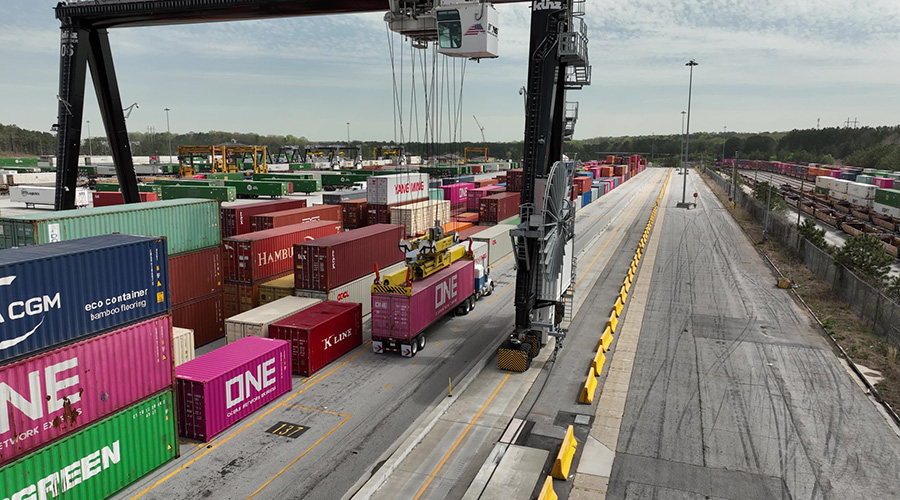NS: Stacking process shrinks Georgia terminal's footprint to inflate intermodal capacity
7/8/2024
By Jeff Stagl, Managing Editor
Norfolk Southern Railway anticipates a boost in intermodal traffic in both the short and long terms. So, having enough capacity at terminals is vital.
To that end, the Class I in March changed the process for handling international containers in Austell, Georgia, from a wheeled system to a stacked container operation.
In a wheeled system, containers are directly transferred to chassis for pick up by a truck driver. By instead stacking containers, terminal space can be maximized.
At the Austell terminal, parking capacity has increased more than 30% because of the operational change, NS officials say. In addition, the terminal has gained the flexibility to handle diverse cargo types and sizes.
“By stacking, we are able to handle anticipated volume growth on a smaller footprint,” said Will DeShazor, NS’ assistant vice president of terminal operations-intermodal and automotive, in an email. “Reducing ground traffic also improves security, ensuring smoother operations and heightened safety.”
The railroad is managing the new operation in Austell with stack optimization technology, which is designed to enhance transparency and optimize yard inventory and crane movements. It also helps ensure inventory accuracy and control.
 By stacking international containers at the terminal, parking capacity has increased more than 30% in Austell. Norfolk Southern Railway
By stacking international containers at the terminal, parking capacity has increased more than 30% in Austell. Norfolk Southern Railway“Inventory is a challenge in stacked environments, where manual inputs are required to manage inventory. An optimized stack uses a disciplined work order approach to monitor every move,” said DeShazor. “The result is — despite thousands of lifts/moves per day — we maintain an accurate inventory of our stack. This saves time and makes the operation more efficient.”
In addition, terminal managers can monitor and measure all moves in a stack. Settings for a stack can be calibrated to distribute work, which helps benefit truck drivers, customers and terminal fluidity, NS officials say.
“Our truck tracking system and work order queueing give us another advantage. This seeks to maximize the crane utilization by ensuring all aspects of a mission are aligned before dispatching work to a crane,” said DeShazor.
A truck tracking software/system is used to confirm that a driver is in the right transfer spot, then work is dispatched to a crane.
“Using this workflow eliminates wasted time and moves,” said DeShazor.
To help truck drivers better understand the new stacking process and to maintain a fluid intermodal operation in Austell, NS created a video tutorial for drivers.
Objectivity and crane operations
The Class I has found that employing an optimized stack process inserts objectivity into the container-handling process. In a non-managed stack operation, crane operators choose work or select drivers, which can mean some drivers get expedited around others, potentially just because they are in the right place at the right time, said DeShazor.
“Using an optimized stack moves this approach to a very calculated flow that is simply evaluating how to perform lifts and service drivers and the terminal most efficiency,” he said.
 NS is managing the new operation with stack optimization technology, which is designed to optimize yard inventory and ensure inventory accuracy. Norfolk Southern Railway
NS is managing the new operation with stack optimization technology, which is designed to optimize yard inventory and ensure inventory accuracy. Norfolk Southern RailwayIn June 2023, NS switched to a stacked operation at its Rossville, Tennessee, terminal. That move served as a precursor to the process switch in Austell, NS officials say.
Many years ago, NS employed legacy stacking operations without modern stacking optimization software at several facilities that used side loader or reach-stacking machines to move containers within a stack. That would involve moving many units to reach a target unit for pick up, impacting the time a driver needed at a terminal to pick up a container.
Once the stacking technology is fully operational in Austell, NS expects to consider employing stack operations at other terminals with similar operating models.
The Class I also is preparing for an increase in intermodal traffic by exploring plans to upgrade, expand and electrify its Livernois Intermodal Facility in Detroit, said DeShazor. The railroad recently was awarded $5 million through the 2023 Michigan Rail Enhancement Fund for the work.
“This is the first step in a multiphase project. Ultimately, the project would convert a legacy rail yard that is currently a grounded inland port international facility to a stacked operation by introducing new overhead gantry cranes, additional pad tracks and paving,” said DeShazor.


